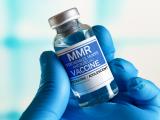Dec 17, 2001 (CIDRAP News) – If bioterrorists released smallpox virus today, each person who contracted the disease could infect as many as 10 to 12 more before health authorities would recognize the disease and act to contain it, according to experts writing in the Dec 13 issue of Nature.
The transmission rate for community-acquired infections would probably be 4 to 6 secondary cases per primary case, but it might be higher, write Raymond Gani and Steve Leach of the Centre for Applied Microbiology and Research at Porton Down in the United Kingdom. They estimate the current level of smallpox immunity due to childhood vaccinations in industrialized countries at 18%.
"For contemporary outbreaks in industrialized countries, which now have low levels of herd immunity (18%, see Methods), an R0 value [transmission rate] of 4-6 would probably apply for community acquired infections, but might transiently be higher (for example, 10-12) before the disease was correctly recognized and appropriate hospital infection controls implemented," the article states.
Over the past three centuries, smallpox transmission rates among unvaccinated people before the implementation of controls were generally in the range of 3.5 to 6, according to Gani and Leach. However, the rates sometimes rose to 10 to 12 among poor, crowded populations and in hospitals, they write. The latter situation occurred in some 20th-century European outbreaks.
The authors derived their estimates using a set of equations involving many epidemic-related variables. They say their estimated transmission rate of 4 to 6 is lower than some other recent estimates and higher than others. "The higher values from 10 to 20 have been estimated from atypical outbreaks with unusually high transmission rates, whereas the lower estimates of around 2 appear to have neglected concurrent herd immunity," they state. "Although our estimate for smallpox represents a relatively modest transmission rate by comparison with some other infectious diseases, such as measles or chickenpox, significant epidemics could result, particularly if there were delays in detecting the first cases or in setting up effective public health interventions."
Gani R, Leach S. Transmission potential of smallpox in contemporary populations. Nature 2001 Dec 13;414(6865):748-51 [Abstract]



















